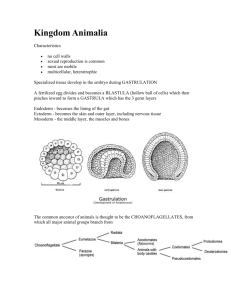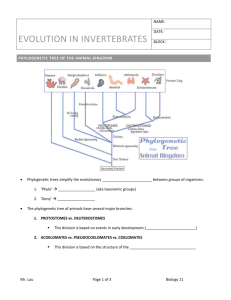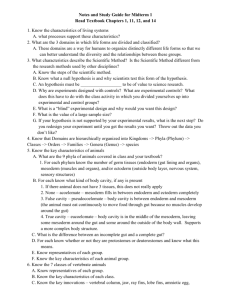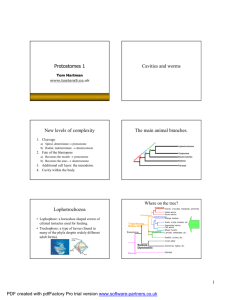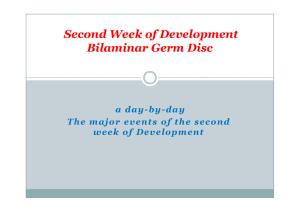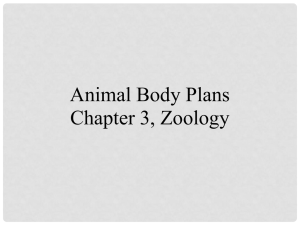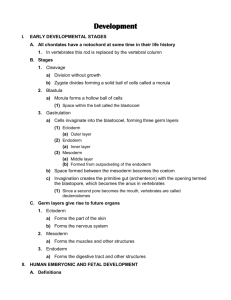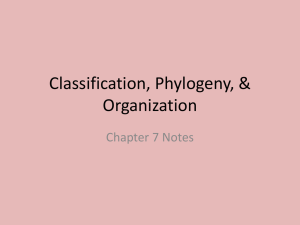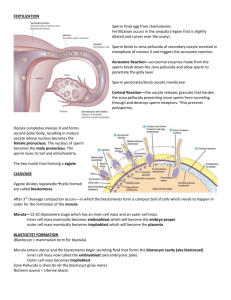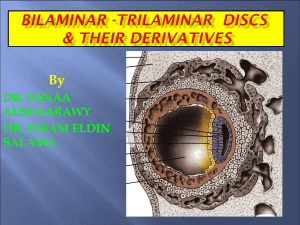Fertilisation & Implantation
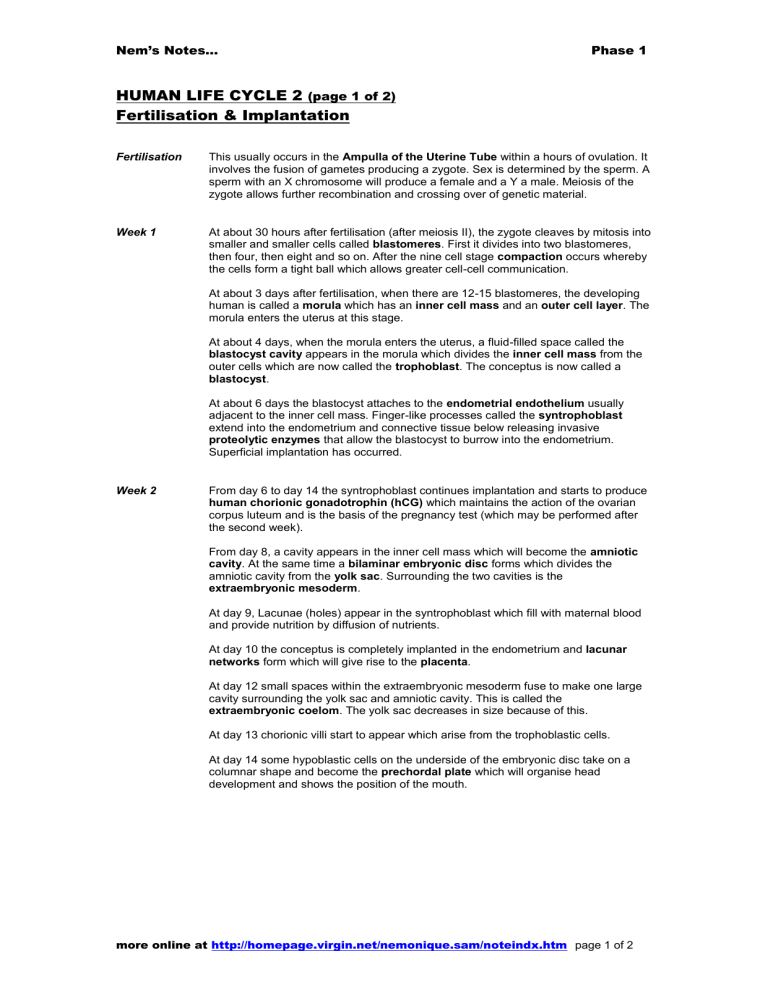
Nem’s Notes… Phase 1
HUMAN LIFE CYCLE 2
(page 1 of 2)
Fertilisation & Implantation
Fertilisation This usually occurs in the Ampulla of the Uterine Tube within a hours of ovulation. It involves the fusion of gametes producing a zygote. Sex is determined by the sperm. A sperm with an X chromosome will produce a female and a Y a male. Meiosis of the zygote allows further recombination and crossing over of genetic material.
Week 1 At about 30 hours after fertilisation (after meiosis II), the zygote cleaves by mitosis into smaller and smaller cells called blastomeres . First it divides into two blastomeres, then four, then eight and so on. After the nine cell stage compaction occurs whereby the cells form a tight ball which allows greater cell-cell communication.
At about 3 days after fertilisation, when there are 12-15 blastomeres, the developing human is called a morula which has an inner cell mass and an outer cell layer . The morula enters the uterus at this stage.
At about 4 days, when the morula enters the uterus, a fluid-filled space called the blastocyst cavity appears in the morula which divides the inner cell mass from the outer cells which are now called the trophoblast . The conceptus is now called a blastocyst .
At about 6 days the blastocyst attaches to the endometrial endothelium usually adjacent to the inner cell mass. Finger-like processes called the syntrophoblast extend into the endometrium and connective tissue below releasing invasive proteolytic enzymes that allow the blastocyst to burrow into the endometrium.
Superficial implantation has occurred.
Week 2 From day 6 to day 14 the syntrophoblast continues implantation and starts to produce human chorionic gonadotrophin (hCG) which maintains the action of the ovarian corpus luteum and is the basis of the pregnancy test (which may be performed after the second week).
From day 8, a cavity appears in the inner cell mass which will become the amniotic cavity . At the same time a bilaminar embryonic disc forms which divides the amniotic cavity from the yolk sac . Surrounding the two cavities is the extraembryonic mesoderm .
At day 9, Lacunae (holes) appear in the syntrophoblast which fill with maternal blood and provide nutrition by diffusion of nutrients.
At day 10 the conceptus is completely implanted in the endometrium and lacunar networks form which will give rise to the placenta .
At day 12 small spaces within the extraembryonic mesoderm fuse to make one large cavity surrounding the yolk sac and amniotic cavity. This is called the extraembryonic coelom . The yolk sac decreases in size because of this.
At day 13 chorionic villi start to appear which arise from the trophoblastic cells.
At day 14 some hypoblastic cells on the underside of the embryonic disc take on a columnar shape and become the prechordal plate which will organise head development and shows the position of the mouth. more online at http://homepage.virgin.net/nemonique.sam/noteindx.htm
page 1 of 2
Nem’s Notes… Phase 1
The Germ
Layers
Spina Bifida
HUMAN LIFE CYCLE 2
(page 2 of 2)
Fertilisation & Implantation
Week 3 At the beginning of the third week the primitive streak starts to develop on the epiblast of the embryonic disc at the caudal end (away from the prechordal plate). It is a result of the creation of intraembryonic mesoderm between the epiblast and hypoblast. As the primitive streak moves further up it forms the primitive groove. The disc is now in three layers (ie trilaminar) consisting of ectoderm, mesoderm and endoderm.
Between the ectoderm and endoderm a notochord starts to develop moving toward the cranial end from the primitive pit (part of the primitive streak). It stops at the prechordal plate.
Above the notochord on the ectoderm, a neural plate develops which gives rise to the
CNS. At day 18 the plate obtains a groove called the neural groove which has neural folds either side of it. As the groove deepens the folds fuse together over the top giving rise to the neural tube which will become the spinal cord. The neural crests develop into the spinal ganglion on either side of the neural tube.
Toward the end of the third week the mesoderm either side of the notochord proliferates into somites . They will eventually give rise to the axial skeleton.
The lateral mesoderm develops small coelomic cavities which coalesce into a single horse-shoe shaped intraembryonic coelom . This will eventually give rise to the major body cavities such as the pericardial, pleural and peritoneal cavities.
Week 4 The intraembryonic coelom is placed more ventrally in the embryo by means of the folding which occurs due rapid growth at the edges of the embryonic disc (including the head). The developing heart is moved into the ventral surface along with the future pericardial cavity. Lateral folding of the disc gives rise to the peritoneal cavity as the coelom is pushed onto the ventral surface of the embryo. The future parietal surface is derived from the somatic mesoderm and the visceral from the splanchnic mesoderm.
The visceral surface will be in contact with the organs while the parietal will be in contact with the thoracic cavity.
Each of the germ layers gives rise to specific organs and tissues.
The ectoderm gives rise to: (a) Epidermis
The mesoderm gives rise to:
(b) Central & Peripheral Nervous Systems
(c) Retina of the Eye
(a) Smooth muscle coats
(b) Connective tissue
(c) Cardiovascular System
(d) Bone marrow and blood cells
(e) Skeleton
The endoderm gives rise to:
(f) Reproductive system
(a) Epithelial linings of respiratory & GI tracts
(b) glands (within the liver, pancreas & GI tract)
Spina bifida is a failure of the spine to fuse properly. There are two forms:
(a) Occulta – occurs in 10% of normal people in L5-S1 verterbrae usually no clinical symptoms.
(b) Cystica – occurs with cyst on the back & can be of three further subtypes
(i) with meningocele
– cyst containing meninges & CSF
(ii) with meningomyelocele – contains spinal cord/roots
(iii) with myeloschisis
– open back due to lack of fusion
Anencephaly is the absence of brain and may accompany spina bifida cystica (ie it is a neuralation defect, whereas spina bifida is a canilisation defect).
These defects can be tested for using amniocentisis or ultrasonography.
more online at http://homepage.virgin.net/nemonique.sam/noteindx.htm
page 2 of 2
